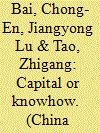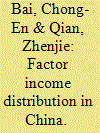|
|
|
Sort Order |
|
|
|
Items / Page
|
|
|
|
|
|
|
| Srl | Item |
| 1 |
ID:
101163


|
|
|
|
|
| Publication |
2010.
|
| Summary/Abstract |
China's success in attracting foreign direct investment has been cast in doubt as mainly a transfer of capital, not knowhow, because its financial system is incapable of allocating domestic savings and hard-earned foreign reserves to domestic enterprises. To shed light on this debate, we examine the determinants of equity sharing in Sino-foreign joint ventures with the premise that the roles of foreign direct investment (in transferring capital or knowhow) should be reflected in equity sharing between multinational firms and local firms. Our empirical analysis offers strong evidence for foreign direct investment as a transfer of knowhow, but limited support for foreign direct investment as a transfer of capital, which points to the need for further reform in China's financial system.
|
|
|
|
|
|
|
|
|
|
|
|
|
|
|
|
| 2 |
ID:
134894


|
|
|
|
|
| Summary/Abstract |
Each year, millions of Chinese high school students sit the National College Entrance Examination (CEE). For the majority of students, the CEE score is the single determinant in whether they gain admission into a college and to what college they enter. The purpose of this paper is to determine whether and how well the CEE score predicts college academic success. We also consider high school achievement and admission route in predicting college grades. We obtain administrative data on CEE and undergraduate GPAs from two Chinese universities with very different rankings. We find that, for both universities the CEE total score predicts undergraduate GPAs for all four years in college. Even the size of the estimates for CEE is similar for the two universities. High school achievement and admission routes are also significant predictors of college grades. However, we do not find consistent results as to which CEE subject test scores predict students' academic performance in college.
|
|
|
|
|
|
|
|
|
|
|
|
|
|
|
|
| 3 |
ID:
101165


|
|
|
|
|
| Publication |
2010.
|
| Summary/Abstract |
This paper investigates changes in aggregate labor share in China during 1978 and 2007 with a particular focus on the 1995-2007 period during which official statistics report a drop of 12.45 percentage points in labor's share of national income (labor share). Our main findings are: (1) The reported fall in aggregate labor share is overstated. According to the official statistics released by the NBS (2007a), the labor share fell 5.25 percentage points from 2003 to 2004. However this dramatic decline, 42.16% of the total reported decline of the labor share from 1995 to 2007, is completely due to the changes in the way NBS break down the operating surplus state-owned and collective-owned farms and the mixed income of the owners of individual economy; (2) For the last three decades, two main forces have been driving shifts in the aggregate labor share: (i) structural transformation between the agriculture and non-agriculture sectors and (ii) shifts in the labor share within the industry sector; (3) From 1995 to 2003, these two effects are both negative and together drive down aggregate labor share by 5.48 percentage points. The structural change explains 61.31% of the decline and the remaining 38.69% of the decline is due to the changes in the labor share within sectors, primarily in the industry sector; (4) Labor share in agriculture is lower than labor share in services. Therefore, when the service sector grows relative to the agriculture sector in the economy, the aggregate labor share of income declines; and (5) Restructuring of the SOEs and expanded monopoly power are the main reasons for the decline of labor share within industry after 1998. Relative price shifts, the factor input ratio, and biased technological progress are all insignificant forces for this decline because the substitution between factors in the industry sector is nearly unit elastic.
|
|
|
|
|
|
|
|
|
|
|
|
|
|
|
|
| 4 |
ID:
134879


|
|
|
|
|
| Summary/Abstract |
This paper utilizes the non-linear estimation method to simulate the Zipf distribution, and constructs an alternative measure of Hirschman–Herfindahl index (HHI), in order to reveal the real changes in monopoly of China's industrial markets. Based on the annual waves of the Chinese Industrial Enterprises Database between 1998 and 2009, it finds that: 1) systematic bias of deceptive declining concentration would be very easy to appear when directly using censored survey data with some invariant threshold; 2) with method in this article, an alternative measure of China's market concentration (namely, the estimated Zipfian parameter) can be produced to better depict monopoly trend, even though small firms are censored out in the market surveys and commonly used HHI cannot avoid such systematic bias; and 3) China actually experiences much less competition improvement or monopoly reduction in many industries during this period.
|
|
|
|
|
|
|
|
|
|
|
|
|
|
|
|
| 5 |
ID:
116520


|
|
|
|
|
| Publication |
2012.
|
| Summary/Abstract |
This paper investigates the spatial structure of the provincial economic growth and the spatial spillover in China from 1998 to 2008. First, we apply Moran's index to detect the positive spatial autocorrelations across the provinces of China. Second, we build a new economic geography model and the role of market potential in promoting regional income growth is highlighted. Third, two measures of market potential are constructed and a spatial error model is adopted to obtain the estimations, considering spatial autocorrelation. Controlling for major inputs, such as labor, capital, and human capital, the market potential continues to promote substantial regional growth. On average, an increase of 10 percentage points in the market potential increases the regional GDP per capita growth by 3-5 percentage points.
|
|
|
|
|
|
|
|
|
|
|
|
|
|
|
|
|
|
|
|
|